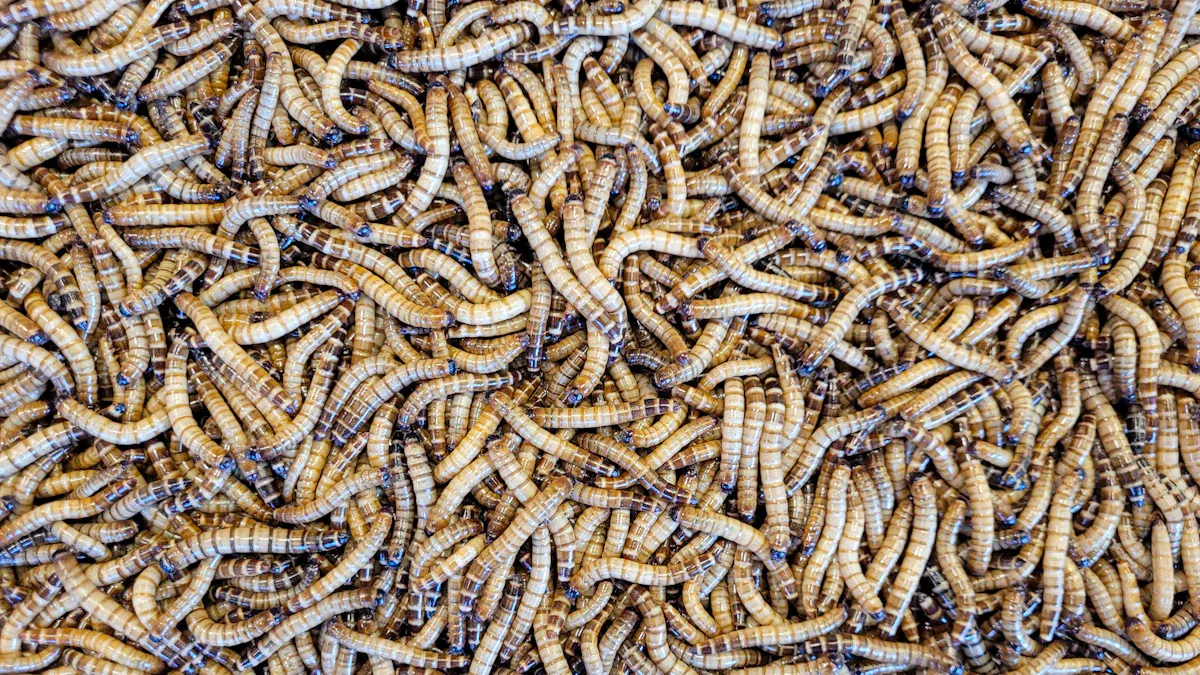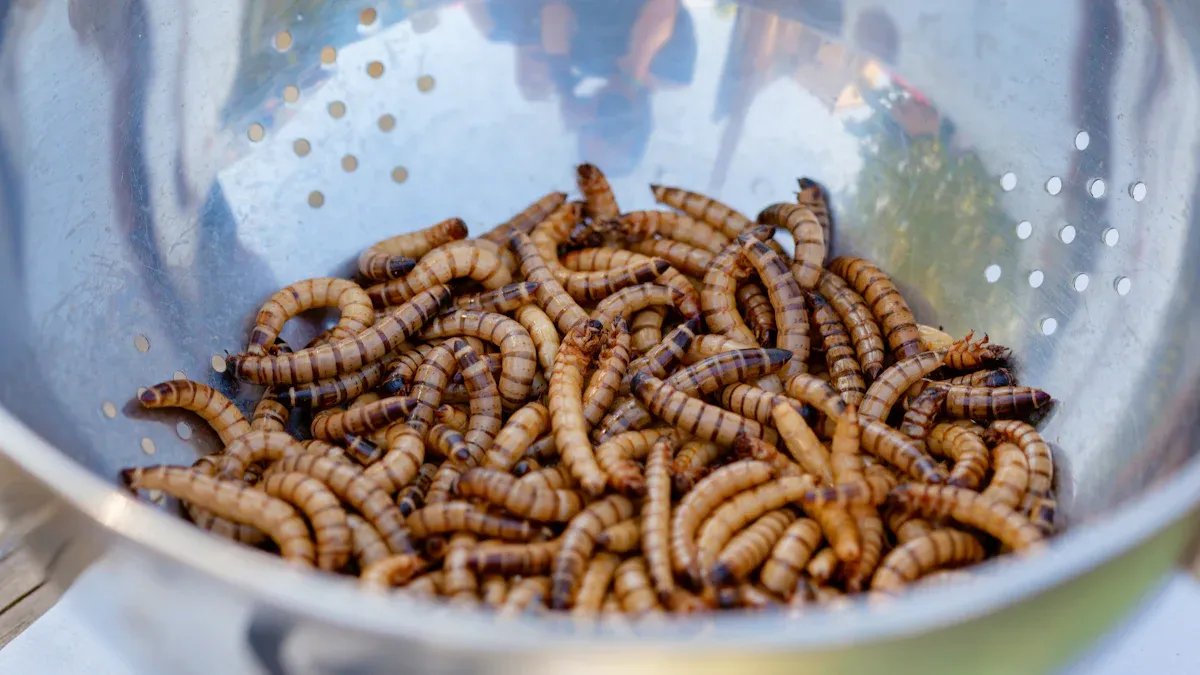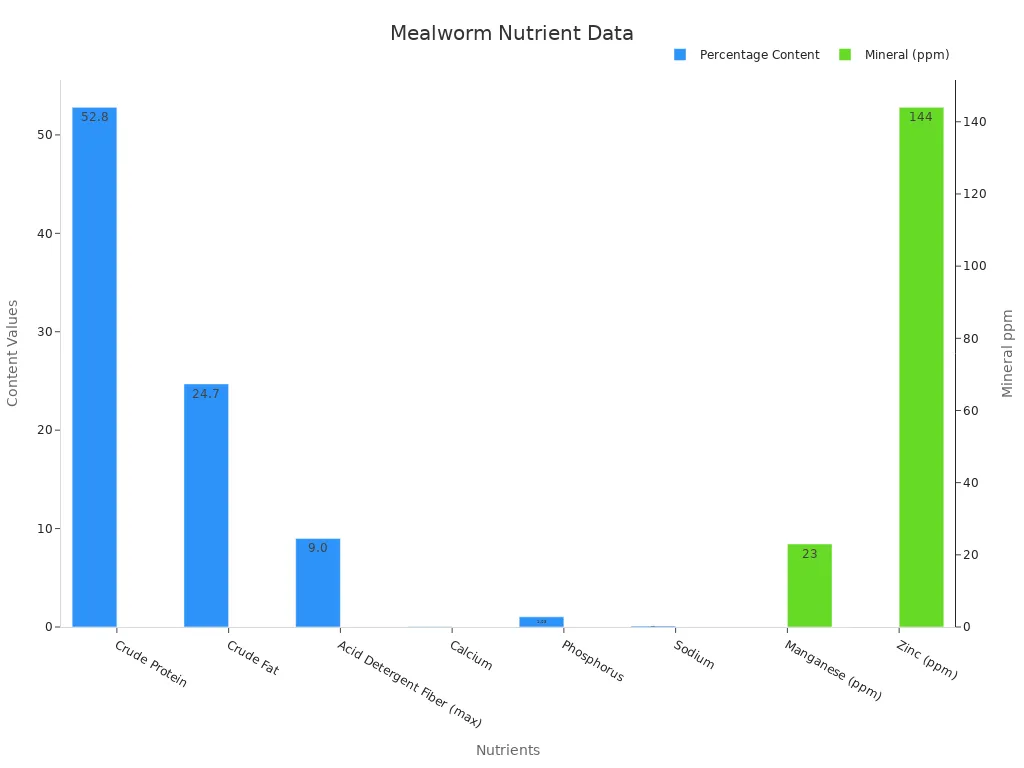
Dried Mealworms for Animal Feed stand out as a smart choice for farmers who want healthy animals and a greener farm. Packed with protein, vitamins, and minerals, these mealworms offer a dense, sustainable feed option.
キーテイクアウト
- Dried mealworms provide high protein and healthy fats that support strong growth and good health in many animals like chickens, wild birds, fish, and small mammals.
- Using dried mealworms helps farmers improve animal productivity and welfare while offering a natural, preservative-free food source.
- Mealworms have a low environmental impact, needing less land and water and producing no methane, making them a smart, eco-friendly choice for sustainable farming.
Dried Mealworms for Animal Feed: Nutrition and Animal Health

High-Protein and Nutrient Profile
Dried Mealworms for Animal Feed pack a powerful nutritional punch. Farmers and pet owners often look for feeds that deliver high protein, healthy fats, and essential minerals. Mealworms stand out because they offer more than 50% protein, making them one of the most nutrient-dense options available. Their protein content rivals that of traditional feeds like fish meal and meat meal, but mealworms also bring a higher fat content, which helps animals maintain energy and healthy growth.
Here’s a quick look at how dried mealworms compare to other common animal feeds:
| Nutritional Aspect | Dried Mealworms (Tenebrio molitor) | Fish Meal | Meat Meal | Poultry Meal |
|---|---|---|---|---|
| Crude Protein (CP) | 46% to 52% | 65.5% to 73% | 65.5% to 73% | 65.5% to 73% |
| Fat Content | 25% to 35% | 9.71% | 11.09% | 13.00% |
| Essential Amino Acid Index | 0.58 | 0.57 | 0.40 | 0.45 |
| Protein Digestibility | ~90% | Slightly lower | Slightly lower | Slightly lower |
Mealworms also contain important minerals like phosphorus and zinc. For example, yellow mealworm larvae have about 51% protein, 19% fat, and 5% ash. These numbers show why so many farmers choose dried mealworms for animal feed.
ヒント: Dried mealworms keep their nutrients well because of careful drying methods like microwave drying, vacuum freeze drying, or sun drying. This means animals get a fresh, high-quality food source every time.

Benefits for Poultry, Chicks, Wild Birds, and Other Animals
Dried Mealworms for Animal Feed work for many types of animals. Chickens, ducks, and other poultry love them. Farmers notice that birds eat mealworms eagerly, which helps them grow strong and healthy. Chicks get a boost in their early days, supporting better feather growth and energy.
Wild birds also benefit from mealworms. During nesting season, birds need extra protein. Mealworms provide this in a natural, easy-to-eat form. Many backyard bird enthusiasts use dried mealworms to attract robins, bluebirds, and other insect-eating species. The preservative-free and additive-free nature of our dried mealworms makes them a safe treat for wild birds.
Other animals like reptiles, fish, and small mammals also enjoy mealworms. Fish take them quickly, making mealworms a popular choice for both feeding and bait. Small mammals such as hedgehogs and sugar gliders benefit from the protein and fat, which support muscle growth and a shiny coat.
- Chickens: Improved feather growth, higher egg production
- Wild birds: Extra nutrition during nesting and migration
- Fish: Eagerly eaten, supports healthy growth
- Small mammals: Better muscle tone, coat health, and mental enrichment
Supporting Animal Health, Productivity, and Welfare
Farmers want animals that are healthy, productive, and happy. Dried mealworms help achieve these goals. Their high protein and fat content support growth, egg production, and overall well-being. Studies show that replacing traditional protein sources with mealworms does not harm animal growth or health. In fact, mealworms can even improve productivity in some cases.
For chickens, mealworms support feather growth and egg laying. For wild birds, they provide vital nutrients during stressful times like nesting. Small mammals and reptiles get a natural, enriching food source that keeps them active and healthy. The long shelf life and easy storage of dried mealworms make them a practical choice for daily feeding or as a special treat.
Our company specializes in breeding and providing high-quality dried mealworms, crickets, and locusts. We use advanced drying methods to ensure every batch is fresh and full of nutrients. Farmers and pet owners can trust that our products are preservative-free and additive-free, supporting animal health and welfare.
Note: Dried Mealworms for Animal Feed offer a sustainable, eco-friendly solution that fits modern farming needs. They require less water and space to produce, making them a smart choice for anyone who cares about the environment and animal welfare.
Dried Mealworms for Animal Feed: Environmental and Practical Advantages
Lower Environmental Footprint and Sustainable Practices
Farmers who choose dried mealworms help the planet. Mealworms need less land and water than cows, pigs, or chickens. They also do not produce methane, which is a harmful greenhouse gas. The table below shows how mealworms compare to other protein sources:
| Environmental Indicator | Mealworms | Milk | Chicken | Pork | Beef |
|---|---|---|---|---|---|
| Global Warming Potential (GWP) | Baseline | 1.77–2.80× | 1.32–2.67× | 1.51–3.87× | 5.52–12.51× |
| Land Use (LU) | Baseline | 43% higher | 35–44% higher | 29–39% higher | 10–13× higher |
| Fossil Energy Use (EU) | Baseline | 21–83% higher | 46–88% higher | 55–137% higher | 1.02–1.58× higher |
| Methane Emissions | None | Present | Present | Present | Present |
Mealworms grow fast and reproduce quickly. They reach maturity in just a few months. This makes them a smart choice for sustainable farming.
Reduced Packaging Waste and Eco-Friendly Initiatives
Dried mealworms come with less packaging waste. Many companies, including ours, use eco-friendly materials for packaging. This helps reduce plastic use on the farm. Farmers can also buy in bulk, which means fewer bags and boxes. Less waste means a cleaner environment for everyone.
Tip: Recycle or reuse packaging whenever possible. Every small step helps protect the planet.
Sourcing, Storing, and Integrating Mealworms on the Farm
Farmers can raise or buy mealworms easily. Here are some best practices for handling mealworms on the farm:
- Keep mealworms at 27°C and 60% humidity with daily light.
- Use wheat bran as bedding and carrots for moisture.
- Feed larvae a mix of brewers’ spent grain and yeast, plus carrots three times a week.
- Harvest larvae after about 56 days, when they reach full size.
- Sift larvae from waste and fast them for 24 hours before drying.
- Store dried mealworms by freezing or freeze-drying to keep them fresh.
- Grind dried mealworms into powder for easy mixing with animal feed.
Cost-benefit studies show that while starting with dried mealworms may cost more than traditional feeds, larger farms can lower costs by producing more. Over time, as technology improves and markets grow, dried mealworms can become even more affordable and practical for farmers.
Dried Mealworms for Animal Feed offer a real solution for sustainable farming. Studies show they keep their nutrition and help farms lower their environmental impact. Farmers see better animal health and less waste. Real-world examples prove mealworms fit well in eco-friendly agriculture. Felix
よくある質問
What animals can eat dried mealworms?
Chickens, wild birds, fish, reptiles, and small mammals all enjoy dried mealworms. They provide a tasty, high-protein treat for many farm and pet animals.
How should farmers store dried mealworms?
Farmers should keep dried mealworms in a cool, dry place. Airtight containers help keep them fresh and safe from pests.
Are your dried mealworms safe for birds and pets?
Yes! The company’s dried mealworms contain no preservatives or additives. They offer a natural, healthy food choice for birds and pets.


